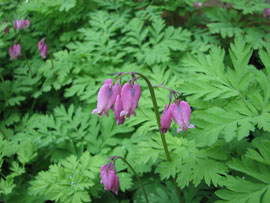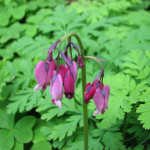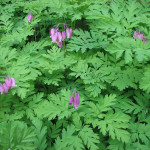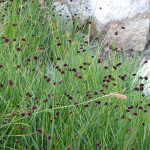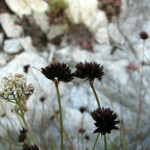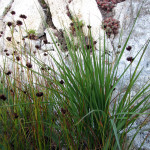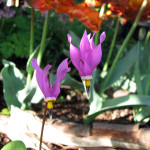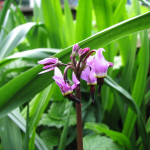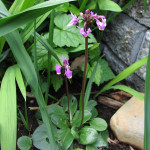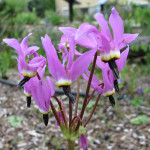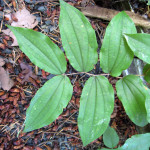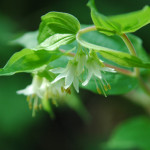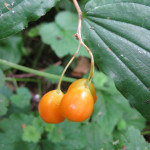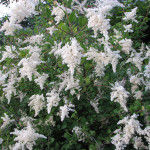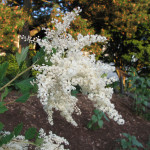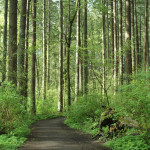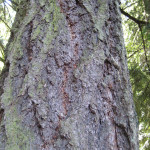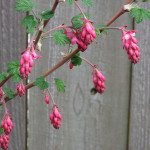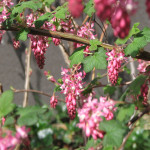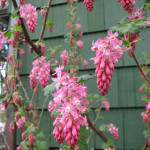Dicentra formosa ssp. formosa
Bleeding heart’s showy flower resembles a heart split open at the base, releasing its contents. It has delicate-looking fernlike leaves, with pink flowers that bloom from April to June. Bleeding heart prefers rich soil and some shade. It will thrive planted under evergreen trees or along stream banks. Heights of 26 inches can be reached though 12-16″ is more common.
- Light Requirements: Part Shade, Full Shade
- Water Requirements: Moist
- Ease of Growing: Easy to grow
- Growth Rate: Moderate
- Spreads:
- Wildlife Support: Hummingbirds, Pest-eating Insects
- Fire-resistant: Yes
- Edible: No
- Mature Height: 1-1.5ft
- Mature Width:1.5-2ft
Dagger-leaf rush

Juncus ensifolius
This rhizomatous rush grows in large upright clumps. The green dagger shaped leaves fold over along the mid-vein towards the stem, similar to iris leaves.
- Light Requirements: Full Sun
- Water Requirements: Moist, Seasonally Wet
- Ease of Growing: Easy to grow
- Growth Rate: Fast
- Spreads:
- Wildlife Support: Birds or Mammals
- Fire-resistant: No
- Edible:
- Mature Height: 1-2ft
- Mature Width:1-2ft
Broad-leaf Shooting Star
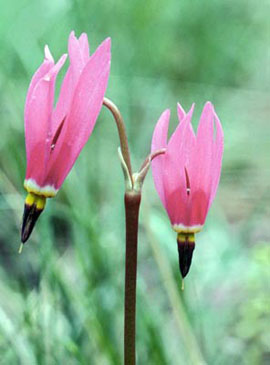
Dodecatheon hendersonii
This bulb-producing perennial begins in late winter with thick spoon shaped leaves at the base of the plant. Showy flowers appear in early spring on top of a tall 12 in (30 cm) leafless flower stalk. Flowers are inside out with petals magenta to deep lavender to white, with a white strip before the black fertile part. It blooms February to May and is summer deciduous, dying back to the ground after the rains cease.
- Light Requirements: Full Sun, Part Shade
- Water Requirements: Moist
- Ease of Growing: Easy to grow
- Growth Rate: Moderate
- Spreads:
- Wildlife Support: Pollinators, Pest-eating Insects
- Fire-resistant: No
- Edible:
- Mature Height: 1ft
- Mature Width:6in
White Alder
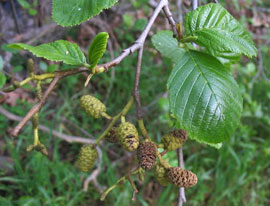
Alnus rhombifolia
Alnus rhombifolia is a medium-sized deciduous tree growing to 49-82 ft rarely to 115 ft tall, with pale gray bark, smooth on young trees, becoming scaly on old trees.
The flowers are produced in catkins. The male catkins are pendulous, yellowish, and produced in clusters of two to seven; pollination is in early spring, before the leaves emerge. The female catkins are ovoid, when mature in autumn and resemble a small conifer cone. The small winged seeds disperse through the winter, leaving the old woody, blackish ‘cones’ on the tree for up to a year after.
The White Alder is closely related to the Red Alder (Alnus rubra), differing in the leaf margins being flat, not curled under. Like other alders, it is able to fix nitrogen atmospheric nitrogen, and tolerates infertile soils.
If used domestically they should be planted well away from drainpipes, sewage pipes, and water lines, as the roots may well invade and clog the lines. These fast-growing trees often grow 3 ft. per year until 20 years of age. They are a relatively short lived species compared to other PNW native tree species.
- Light Requirements: Full Sun, Part Shade
- Water Requirements: Moist, Seasonally Wet
- Ease of Growing: Easy to grow
- Growth Rate: Fast
- Spreads: No
- Wildlife Support: Birds or Mammals
- Fire-resistant: No
- Edible: No
- Mature Height: 90ft
- Mature Width:40ft
Hooker’s Fairy Bells
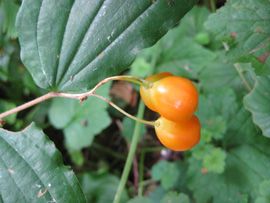
Disporum hookerii
Lovely, outwards-flaring flowers of greenish-white to cream over deep green leathery foliage, with characteristic long, drip-tips to the leaves.
- Light Requirements: Part Shade, Full Shade
- Water Requirements: Moist
- Ease of Growing: Easy to grow
- Growth Rate: Moderate
- Spreads:
- Wildlife Support: Pollinators, Birds or Mammals
- Fire-resistant: No
- Edible:
- Mature Height:
- Mature Width:
Oceanspray
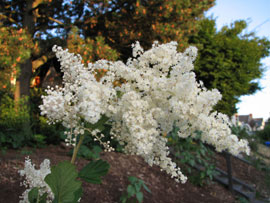
Holodiscus discolor
Oceanspray is native to western North America, most commonly found in the mountains of the Pacific Northwest. This fast-growing deciduous shrub gets 8-10′ tall and 3-7′ wide. Its small toothed leaves are 2-4 inches long. Cascading clusters of white flowers drooping from the branches give the plant two of its common names, oceanspray and creambush. The flowers have a faint sugary scent, and each one bears a small, hairy fruit containing one seed which is light enough to be dispersed by wind.
Oceanspray is found in a variety of habitats, from wet coastal forests to drier, cooler mountain peaks further inland. It often grows in areas dominated by Douglas-fir. The plant is found in areas prone to wildfire, such as chaparral communities. It is often the first green shoot to spring up in an area recovering from a burn or logging.
Many small solitary bees, bumblebees, and native butterflies visit this plant for nectar. It can also be considered a pollinator “nursery”, as pale swallowtail, spring azure, Lorquin’s admiral, and brown elfin butterflies all lay their eggs on it.
These attractive shrubs thrive on dry slopes in sun to part-sun, and spread well in favorable conditions. Long-leaf Oregon grape and salal do well in their shade, and they pair well with hazelnut to make a woodland border. Combine with red-flowering currant or vine maple for a deciduous screen.
- Light Requirements: Full Sun, Part Shade, Full Shade
- Water Requirements: Dry, Moist
- Ease of Growing: Easy to grow
- Growth Rate: Fast
- Spreads: Yes
- Wildlife Support: Pollinators, Pest-eating Insects, Birds or Mammals
- Fire-resistant: Yes
- Edible: No
- Mature Height: 8-10ft
- Mature Width:3-7ft
Douglas Fir
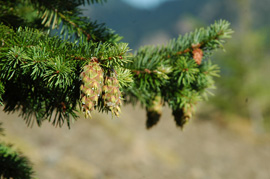
Pseudotsuga menziesii
Douglas fir is one of the most common evergreen trees in the our region. It grows fast and can tolerate many soil types. This is a good tree to plant in groups as a windbreak, or at the edge of wooded areas, as it needs plenty of space.
The bark is thin, smooth, and gray on young trees, and thick and corky on older trees. The needle-like leaves are spirally arranged and 2-3.5 cm long, and a bud at the tip of most branches distinguishes it from other evergreens. Douglas fir foliage has a noticeable sweet fruity-resinous scent, particularly if crushed. The 2-4 inch long cones are green in spring, maturing to orange-brown in the autumn 6-7 months later. The male cones disperse yellow pollen in spring.
Many kinds of wildlife depend on Douglas fir for winter forage. Mice, voles, shrews, chipmunks, pine siskins, song sparrows, golden-crowned sparrows, white-crowned sparrows, red crossbills, dark-eyed juncos, and purple finches all eat the abundant seeds. Black-tailed deer and elk will eat the seeds late in winter when other forage is scarce. The Douglas squirrel harvests and caches great quantities of Douglas fir cones for later use, and the squirrels will also eat mature pollen cones, the inner bark, terminal shoots, and tender young needles.
Fun facts: Douglas fir (Pseudotsuga menziesii) is neither a true fir, nor is it a hemlock (hence the Latin name, *Pseudo*tsuga). It is its own genus altogether. It is also the second-tallest evergreen in the world after the Coast Redwood. Trees 200-250 feet or more in height and 5-6 feet in diameter are common in old growth stands, and heights of 300-400 feet were reported by early lumbermen. It commonly lives more than 500 years and occasionally more than 1,000 years.
- Light Requirements: Full Sun, Part Shade
- Water Requirements: Dry, Moist, Seasonally Wet
- Ease of Growing: Easy to grow
- Growth Rate: Fast
- Spreads: No
- Wildlife Support: Birds or Mammals
- Fire-resistant: Yes
- Edible: No
- Mature Height: 120-240ft
- Mature Width:30ft
Red Flowering Currant
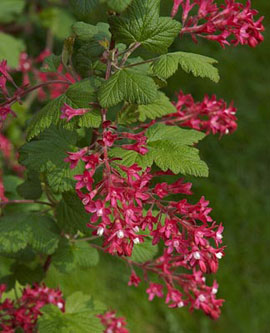
Ribes sanguineum var. sanguineum
Red flowering currant (Ribes sanguineum) is an upright, multi-stemmed deciduous shrub that can get 6-10 feet tall, and is considered one of our prettiest native shrubs. Its bright pink, dangling flower clusters in late February and March are welcome signs of spring!
The bark is dark brownish-grey with pale brown lenticels. The palmate leaves have five lobes, and young leaves and flowers have a scent variously described as spicy or resinous. The fruits form as clusters of dark purple berries which contrast beautifully with the rosy gold fall foliage.
Keep a pair of binoculars handy if you plant this lovely shrub, because red flowering currant is a favorite of hummingbirds and other wildlife all year long. The flowers are important early spring nectar sources for rufous and Anna’s hummingbirds, spring azure and mourning cloak butterflies, and many native bees. Many birds eat the berries in the fall and winter, including towhees, thrushes, cedar waxwings, and sparrows. This charming plant also hosts the eggs of zephyr butterflies, and provides shelter for songbirds.
Red flowering currant can tolerate shade, but grows best (and blooms the most) in sunny locations with well drained soils.
- Light Requirements: Full Sun, Part Shade
- Water Requirements: Dry, Moist
- Ease of Growing: Easy to grow
- Growth Rate: Fast
- Spreads:
- Wildlife Support: Pollinators, Hummingbirds, Pest-eating Insects, Birds or Mammals
- Fire-resistant: Yes
- Edible: Yes
- Mature Height: 4-10ft
- Mature Width:3-10ft

